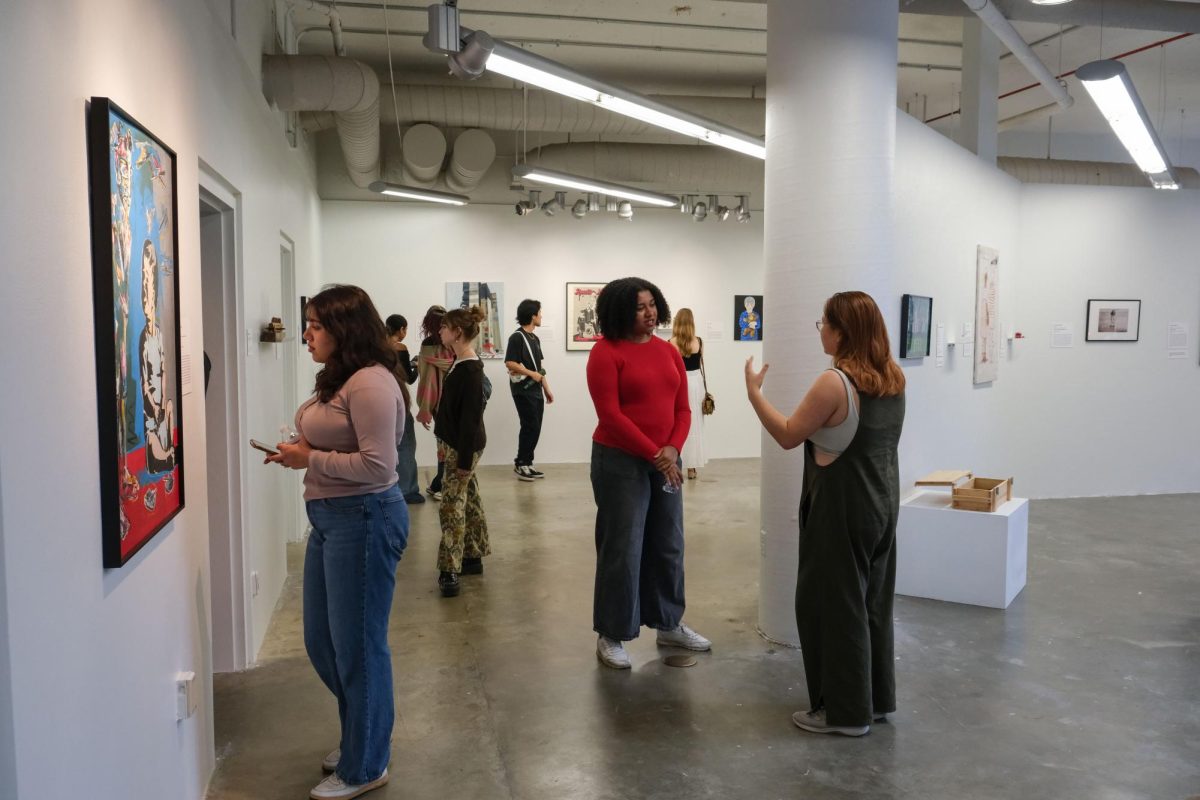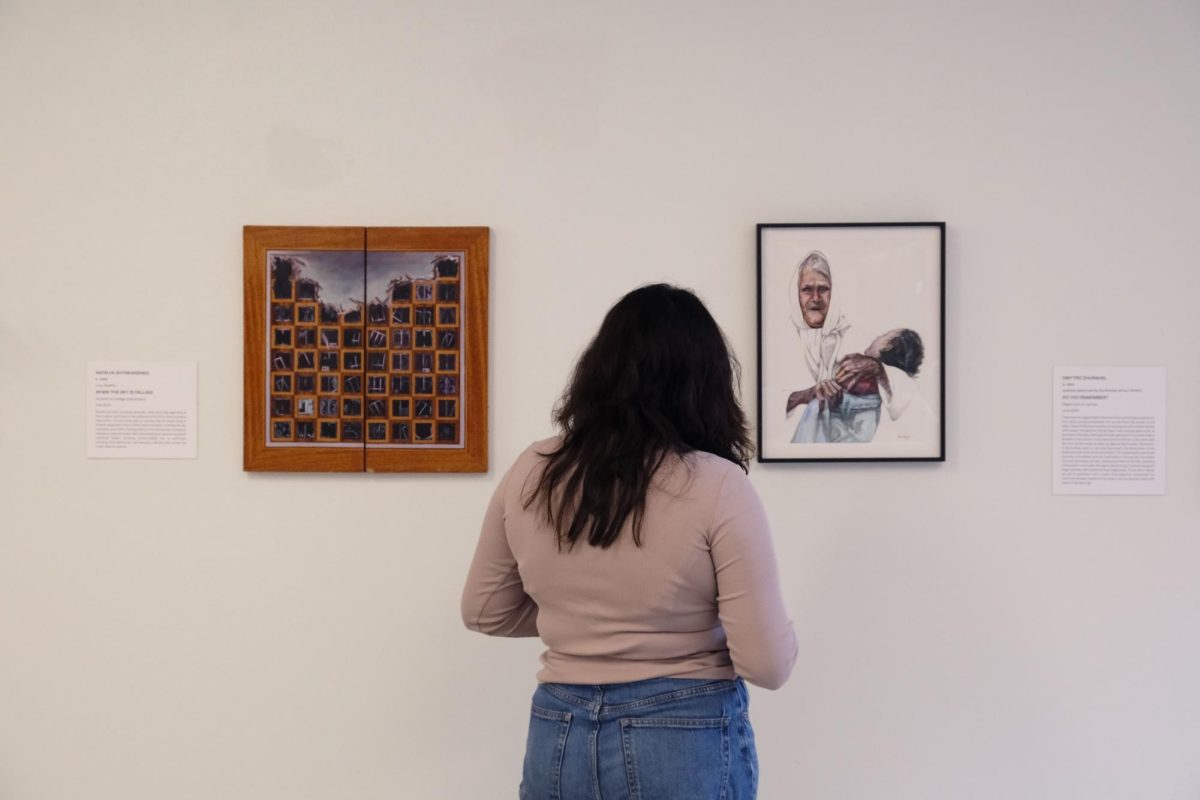A Ukrainian soldier’s military ID card, fragments from a Russian jet and a propeller from an Iranian drone sat on display at the Smith Hall of Art for over a month in an exhibit that concluded Sept. 28.
The exhibition, titled “We Know Who They Are” spotlights a curation of Ukrainian artwork developed by junior Benjamin Cunningham, a political science and fine arts student, and Yevgen Nemchenko, a professional Ukrainian artist. Cunningham said the project serves as a reminder of the need to preserve Ukraine’s cultural identity amid the ongoing war with Russia, which has escalated in the past two years following Russia’s invasion of the country.
The gallery featured stark white walls, where paintings of areas desecrated by the war were hung on the walls next to pieces of debris from the front lines of the conflict. At the entrance to the exhibit, Cunningham operated a table where he sold merchandise, whose proceeds go to the artists to fund future cultural projects and ranged from $10 stickers and postcards to $50 hoodies of the “We Know Who They Are” brand.
Cunningham said the exhibition began as a project for his first-year dean seminar “Intro to International Humanitarian Assistance” with Michelle Kelso, a professor of sociology and international affairs. He said Kelso encouraged students to “engage in various means of advocacy for Ukraine,” which prompted him to propose an on-campus exhibition of Ukrainian art two years later.
“Her passion and dedication to human rights amid international crises, specifically regarding the war in Ukraine, wholly encouraged me to consider ways to employ my skills within the context of international conflict,” Cunningham said in an email.
The Ukrainian-American Student Association collaborated with Cunningham’s exhibit to host an event Friday at Smith where community members observed the artwork and ate Ukrainian cuisine.
Cunningham said Aydan Ibadova, the president of the UASA, emailed him earlier this month to introduce herself and discuss a potential collaboration with the ongoing exhibit. He said he and Idadova worked together to develop the name and description of the event and eventually chose to title it “Ukrainian Voices Through Art.” He said the UASA catered food for the event and promoted it through community members within the Elliott School of International Affairs and the school’s Institute for European, Russian and Eurasian Studies.
“They also were incredibly communicative and responsive to any questions I had pertaining to the event,” Cunningham said in an email. “Moreover, Aydan and her team did a wonderful job promoting, putting out flyers, posting on social media, and alerting all the relevant names at the Elliott School and the Institute for European, Russian, and Eurasian Studies.”
Cunningham said the artwork in the exhibit show the country’s “present identity” and serve as a “testament to the resilience” of Ukrainian people amid threats to their sovereignty like Russia’s annexation of Crimea in 2014. He said the exhibit featured 22 works of art and 10 artifacts by different Ukrainian artists focused on their firsthand experiences navigating the violence surrounding them.
“Hosting this exhibition in the United States, specifically Washington, D.C., this exhibition was also of critical importance as funding for Ukraine has been a controversial topic among the partisan divide in the American political system,” Cunningham said in an email.

Before Russia’s invasion of Ukraine, the two countries have faced decades of political and territorial strife, following Ukraine’s independence from the former Soviet Union in 1991 and Russia’s annexation of Crimea in 2014. Since the invasion, Ukraine has regained more than 54 percent of formerly Russian-occupied territory and received more than $278 billion dollars in aid from the U.S.
Cunningham said the country’s constant exposure to conflict due to its shared history and border with Russia created a stronger awareness of the need for cultural identity among Ukrainians. He said violence in Russian-controlled parts of Ukraine like the Bucha Massacre, in which Russian troops killed dozens of Ukrainian civilians over a matter of weeks in March 2022, and the Nova Kakhovka Dam breach in the southern part of the country in 2023, were subjects some artists centered their work around.
In December 2022, a United Relations report said the agency had documented the murders of 73 civilians — which included 54 men, 16 women and three children — in Bucha, a town northeast of Kyiv, Ukraine’s capital city that was under Russian control from March 5 to 30. In June 2023, the Nova Kakhovka Dam, which served as a water supply for some Ukrainian communities, was breached, though it’s still unclear whether the damage was caused by an attack or the dam’s condition.
Cunningham said the exhibit serves as a form of “cultural protectionism and survival” because Russian forces have stolen thousands of pieces of Ukrainian art and artifacts since their invasion of the country in 2022.
“Presenting the localized perspectives and storylines of the artists has allowed us to heighten the visibility of Ukrainians amid the conflict while preserving the artwork in an exhibition catalog,” Cunningham said in an email.
Cunningham said he plans to conduct research with Kelso in the future to understand how art can serve as a tool in documenting war and shape people’s perceptions about a conflict. The exhibition in Smith Hall Gallery was curated by Conflicted Art, an organization founded by Cunningham and Nemchenko after Russia’s invasion in 2022.
The organization aims to financially support Ukrainian artists and strengthen the “artistic ties” between the U.S. and Ukraine. Some artists currently reside in Ukraine, like artist Eugene Baraban who lives in Kyiv. His piece “Russia and the Bear” was displayed in the exhibit.
Cunningham said the event was a “space for cultural exchange” among students from a diverse set of backgrounds.
“We had students from across art history, studio arts, Eastern European studies, and Political science,” Cunningham said in an email. “Throughout the evening, there was almost a constant exchange of dialogue between students, faculty, and visitors, and we hope to continue such events and expand our promotion.”
The exhibit also featured an interactive display video, where a looped video of many of the artifacts were shown. One of the videos that was included showed the Iranian drone being shot down, from which the propeller was recovered and displayed in the exhibit.
Cunningham said the art displayed in the exhibit was shipped directly from Ukraine starting in March which all arrived by this June. He said some shipments, primarily those that contain ballistic artifacts, couldn’t be transferred to the U.S.
“Even using a ballistics expert, the Ukrainian government and mail could not transfer ballistics artifacts such as Russian mortal shells,” Cunningham said in an email.
Sophomore Hattie Craig, the vice president of UASA, said people should be reminded of the “atrocities” still happening in Ukraine and it’s easy to forget the violence and the impact the war has had among civilians.
“It’s so important to be reminded and to see the perspective of these artists and hear what they have to say about the war,” Craig said.
Ibadova, the president of UASA, said she grew up in Azerbaijan, which has consistently provided humanitarian aid and medical services to Ukrainians since Russia’s invasion. She said many people treat the ongoing war from a “nonemotional point of view” and hoped the exhibit helped change people’s perceptions by humanizing the conflict.
“This is not just something people in political science should study as a case, but rather something that they should feel emotional about,” Ibadova said.





